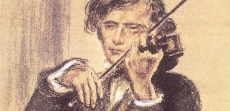
Symphony no. 3 in F major, op. 90 is stylistically different to any of Brahms’ previous works, and demonstrates the progression of Brahms as a composer. Published in 1883, the symphony is illustrative of the power of nature. Here we see a break from tradition. Rather than following Beethoven’s discipline of placing emphasis on the development sections, Brahms places the compositional emphasis upon the themes instead.
The first movement is very cheerful in its sentiment, and uses a simple two bar melodic motive as a focal point. These two bars subsequently influence the rest of the movement, leading to expansive developments and more elaborate melodies. Brahms incorporates the ever effective technique of juxtaposition, using his theme, but having it reappear in a major key, then a minor, and back to major, etc. Certainly this is not only interesting to listen to, creating a great sense of momentum for the piece already, but is also therefore very representative of the capriciousness of nature, that he was trying to portray. Again, within the melodies themselves, there is a continuous movement between ascension and descent, and a contrast between instrumental lines; i.e the woodwinds playing a descending melody as the violin plays an ascending theme.
The second theme is written for clarinet, and continues to provide the piece with a number of transformations. The clarinet plays a lower pitched legato melody with varying saturation of notes; varying between longer sustained but fewer notes, and shorter but more frequent notes. In the development of the symphony, this theme is played in a minor key, creating a more sombre tone. A sostenuto version of the theme in E-flat is used to complete and therefore end the developmental section. A coda then enters, employing the initial theme in a softly played manner to bring the allegro to a slower and more serious end.
An andante in C major is featured within the symphony, wherein Brahms uses ornamentation in order to create a different and more ‘plaintive’ tone, rather than offer drastically different variations. The sombre clarinet is once again playing, now accompanied by the deep bassoon. However, this melody is not reprised at any point further in the symphony; the subsequent phrase which includes deliberate dissonances does return to complete the movement.
The third movement strikes a much more miserable tone than the earlier parts of the symphony, with a graceful cello melody as the introduction. Instead of a trio, we have a woodwind section complimenting the middle of the cello theme in A flat, with a middle pitched steady paced, rather resigned melody. The purpose of this movement seems to be to ‘prepare the way for the passionate and often darkly agitated Finale,’ and allegro in F minor.
An eerie tone that dances up and down in smooth legato leading into diminished notes opens the finale. Trombones join the instrumentation, serving to further emphasize the unnerving nature of the movement, swapping between deep, powerful sustained chords, and quick melodies. Violins are subsequently introduced, adding yet another dynamic. They play brief notes, fluctuating between high and low octaves, pausing to add syncopations and give a sense of breathless frenzy. The cellos seem to provide that Brahmsian contrast, playing an almost joyful melody with gentle rises and falls in triplets, directed as forte. It is almost as though there is a visible conflict occurring, with the wild violins and trumpets almost alternating each other. A powerful note from the bassoon moves the finale into a section of sostenuto, before we see the original glorious theme reappear. This symphony by Brahms is particularly impressive due to it successfully conveying the power and movement of nature, alongside its beauty due to the deviation to focus compositionally upon themes.
Image1: http://www.classicfm.com/composers/brahms/guides/violin-concerto-jane-jones/

0 Comment:
Be the first one to comment on this article.